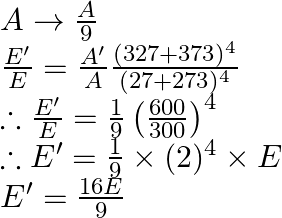Answer is (D)
![]()
When ![]() and
and ![]() changes to
changes to ![]() is and
is and ![]()

A black rectangular surface of area ‘A’ emits energy ‘E’ per second at  . If length and breadth are reduced to
. If length and breadth are reduced to  rd of initial value and temperature is raised to
rd of initial value and temperature is raised to  then energy emitted per second becomes
then energy emitted per second becomes
A)
B)
C)
D)
A)
B)
C)
D)
A black rectangular surface of area ‘A’ emits energy ‘E’ per second at  . If length and breadth are reduced to
. If length and breadth are reduced to  rd of initial value and temperature is raised to
rd of initial value and temperature is raised to  then energy emitted per second becomes
then energy emitted per second becomes
A)
B)
C)
D)
A)
B)
C)
D)
